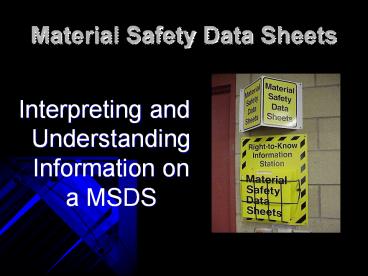Material Safety Data Sheets PowerPoint PPT Presentation
Title: Material Safety Data Sheets
1
Material Safety Data Sheets
- Interpreting and Understanding Information on a
MSDS
2
Toxic effects of Laboratory Chemicals
- In order to minimize the hazards associated with
chemicals used in the laboratory the researcher
must investigate many sources of information to
safely design an experiment. There are many ways
to do this. The starting point should be with a
review of a MSDS.
3
Hazard Communication
- Hazard Communication Standard
- 29CFR 1910.1200
- OSHA published in 1988, requires, chemical
manufacturers or importers to evaluate the
hazards of the products they supply and summarize
this information on Material Safety Data Sheets
(MSDS), shipping labels, and product warnings
4
Material Safety Data Sheets (MSDS)
- Required to provide lab workers with proper
procedures for handling substances safely - Each MSDS is unique to a specific compound and
manufacturer - When reagents are ordered, and MSDS is shipped
with them - MSDS also available online or on discs
5
What is on a MSDS?
- Company and chemical ID
- Name, address and telephone number of
manufacturer - Formula (composition)
- Health Hazards
- Primary routes of entry into body
- Any general precautions for safe handling and use
of the chemical - Physical and chemical properties
- Emergency and First aid procedures
- Stability and reactivity
- Toxicology information
- Preventative measures
- Waste disposal
- Storage
- Spills or leaks
- MSDS date of preparation
6
(No Transcript)
7
Routes of Exposure
- Inhalation - Most common route of exposure, lungs
are designed for maximum transport and adsorption
of vapors, large surface area (1000 sf) - Dermal Second most common route of exposure,
lipid (pass with greater ease) and water soluble
chemicals can pass through the skin. Has 20 sf
surface area. - Ingestion can occur through food contamination,
eating drinking in lab, poor hygiene, mucociliary
transport of vapors trapped in upper air ways, - Injection Can occur through injury and needle
sticks
8
Lethal Dose
- An LD50 value is the amount of a solid or liquid
material that it takes to kill 50 of test
animals in one dose. The dose may be administered
orally (by mouth), or injection into various
parts of the body. The value is usually reported
along with the administration method.
9
Acute Toxicity Levels
10
(No Transcript)
11
MSDS Labels
12
RedFlammability
- 73 F (22 C) and a boiling point below 100 F.
- 4-Materials with a flashpoint below 73 F and
a boiling point below 100 F3-Materials with a
flashpoint below 73 F and a boiling point greater
than or equal to 100 F (38 C) or a flashpoint
above 73 F and less than 100 F. 2-Materials
with a flashpoint above 100 F, but not exceeding
200 F (93.3 C).1-Materials with a flashpoint
above 200 F.0-Materials which normally won't
burn.
13
Blue-Health Hazard
- 4-Materials with an oral LD50 of less than or
equal to 5 mg/kg.3-Materials with an oral LD50
above 5, but less than 50 mg/kg.2-Materials
with an oral LD50 above 50, but less than 500
mg/kg.1-Materials with an oral LD50 above 500,
but less than 2000mg/kg. - 0-Materials with an oral LD50 above 2000mg/kg.
14
YellowReactivity Hazard
- 4-Material is capable of explosion or
detonation at normal temperature and
pressure.3-Material is capable of explosion,
but requires a strong initiating source, or the
material reacts with water.2-Material undergoes
violent chemical changes at elevated temperature
and pressure.1-Normally stable, but can become
unstable at elevated temperatures.0-Normally
stable.
15
White Special Hazard
- W Water Reactive
- Ox Oxidizer
- COR Corrosive
- Radiation

